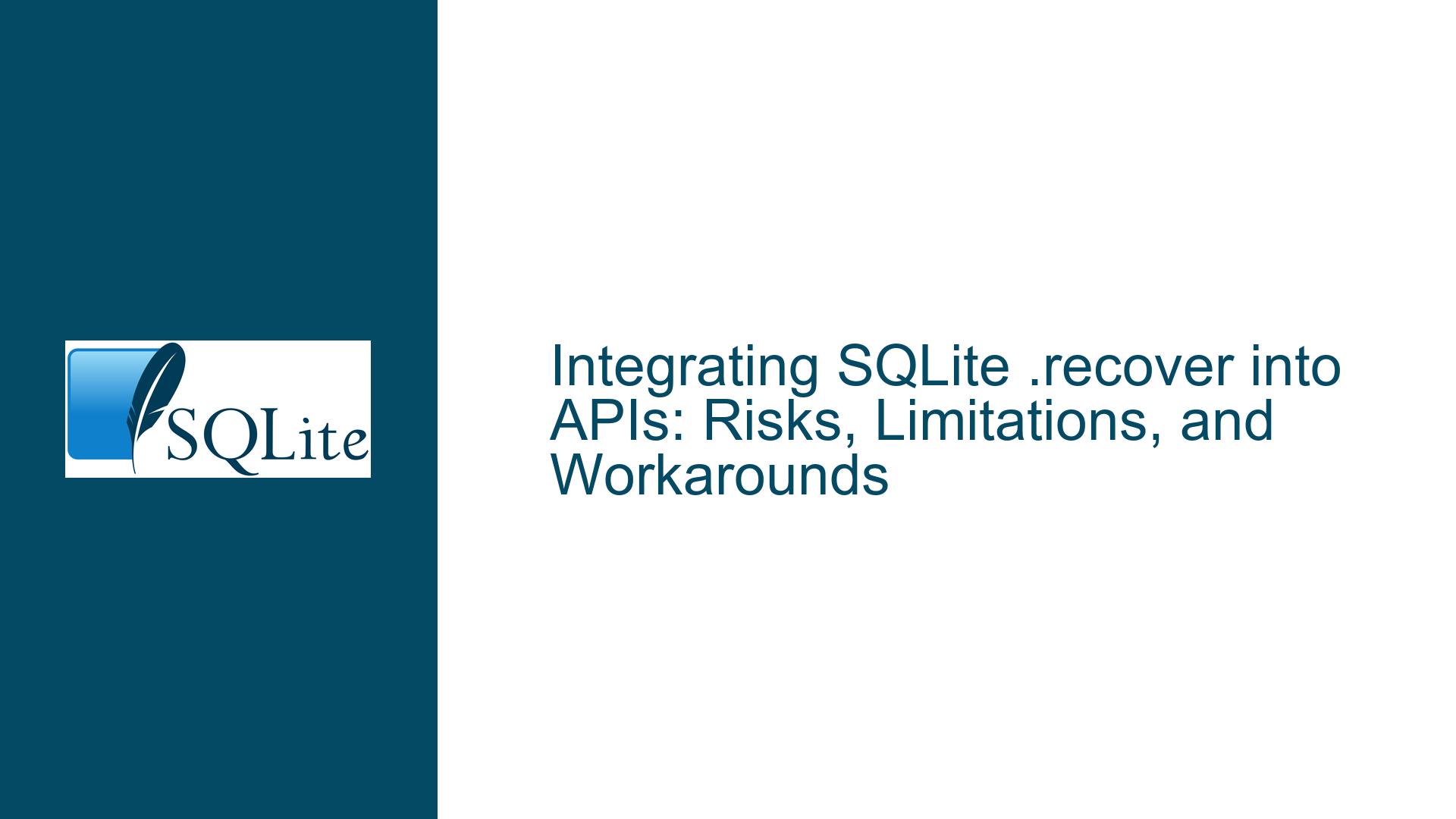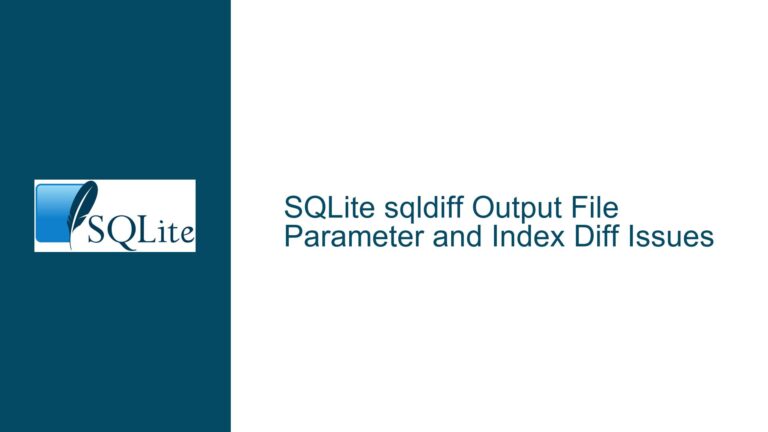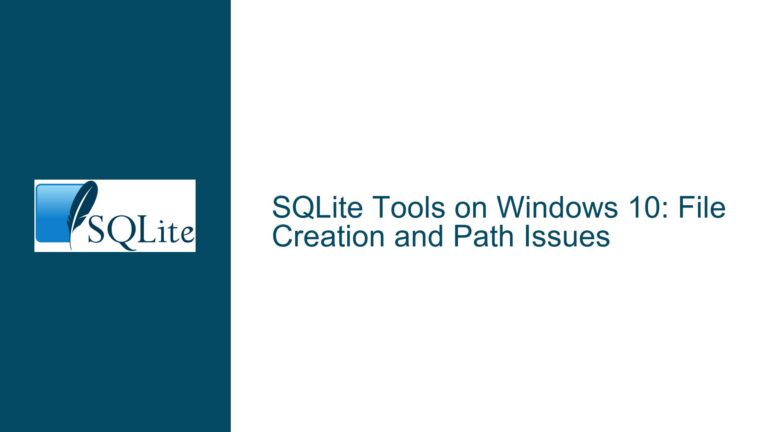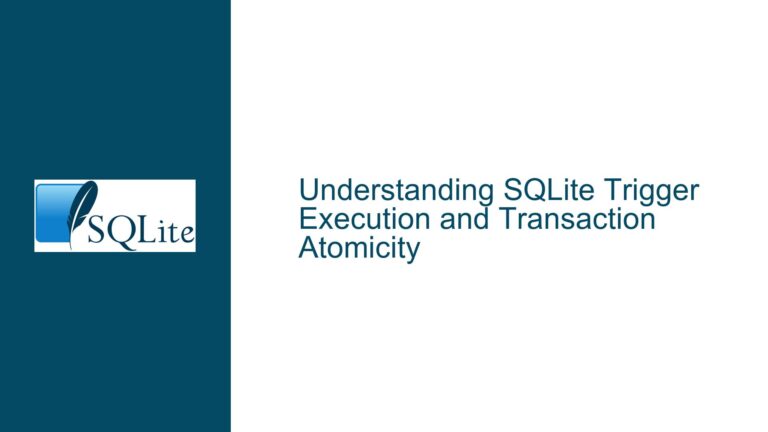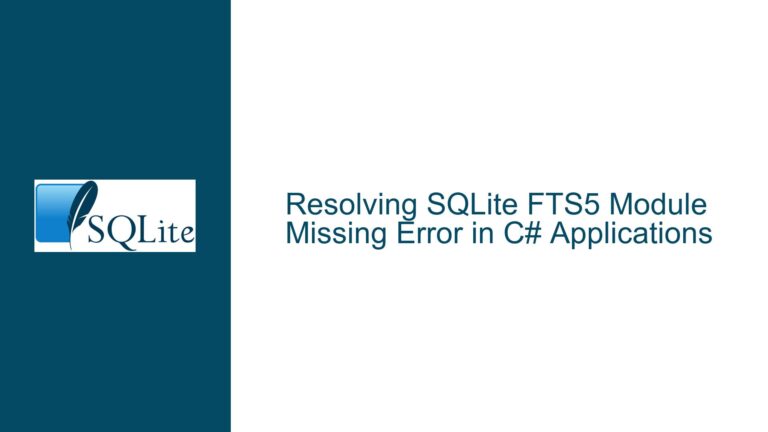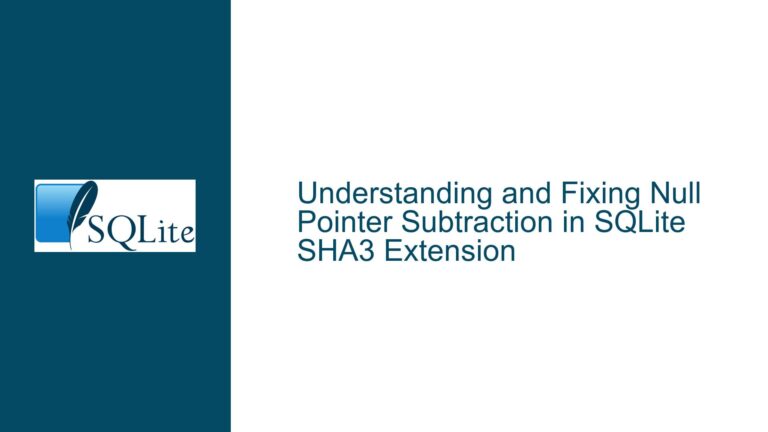Integrating SQLite .recover into APIs: Risks, Limitations, and Workarounds
SQLite’s .recover Command and Programmatic Access Challenges
The SQLite command-line shell’s .recover utility is a powerful tool for salvaging data from corrupted database files. It works by systematically extracting readable content from all database pages, bypassing standard integrity checks to maximize data recovery. This functionality has sparked interest in exposing .recover through SQLite’s public C API, enabling developers to integrate database recovery directly into applications or libraries like the Perl DBD::SQLite module. However, integrating .recover programmatically introduces significant technical, philosophical, and practical challenges. SQLite’s design prioritizes reliability and data integrity, and automating recovery poses risks that conflict with these principles. This guide explores why .recover remains confined to the command-line interface (CLI), the inherent dangers of programmatic recovery, and alternative strategies for handling database corruption in applications.
Technical Mechanics of the .recover Command
The .recover command operates by scanning the database file at a low level, bypassing SQLite’s transactional safeguards. Unlike standard queries, which rely on the database’s schema and transactional consistency, .recover ignores structural integrity and extracts data from individual pages. It reconstructs tables and indexes by brute-force parsing of raw storage, which may include orphaned pages, partially written records, or invalid pointers. This approach maximizes data retrieval but inherently risks incomplete or inconsistent output. For example, if a table’s root page is corrupted, .recover might salvage rows from leaf pages but fail to reconstruct the table’s full hierarchy.
The CLI’s .recover command generates SQL scripts that recreate tables and insert recovered data, allowing users to rebuild databases manually. This process requires human judgment to verify the integrity of recovered data, resolve conflicts (e.g., duplicate primary keys), and discard irrecoverable fragments. Programmatic execution of such logic would lack this oversight, potentially propagating corruption or data loss into new databases without warning.
SQLite’s Existing Corruption Handling Mechanisms
SQLite already includes robust mechanisms to handle common corruption scenarios, such as incomplete writes due to power loss or filesystem errors. The write-ahead log (WAL) and rollback journal ensure atomic transactions, and the PRAGMA integrity_check command identifies structural inconsistencies. When opening a database, SQLite automatically repairs certain issues, such as rebuilding the WAL index or rolling back uncommitted transactions. These built-in features operate silently and are considered safe for programmatic use. However, they are limited to scenarios where the database’s logical structure remains intact.
The .recover command addresses severe corruption that bypasses these safeguards, requiring deliberate, human-driven intervention. Exposing it via the API would blur the line between automated recovery (which SQLite already handles) and manual salvage operations (which require expertise). This distinction is critical: automated systems cannot reliably decide when to prioritize data salvage over integrity, nor can they assess the business impact of partial data loss.
Risks of Silent Data Loss and Automated Recovery Misuse
Data Salvage vs. Data Integrity Trade-offs
The primary risk of programmatic .recover integration is silent data loss. When recovery is automated, applications might overwrite or discard corrupted databases without notifying users, leading to irreversible data destruction. For example, an application might attempt recovery, create a new database with salvaged data, and delete the original corrupted file. If the recovery missed critical records, users would have no recourse. The SQLite team emphasizes that .recover is a last-resort tool, not a routine maintenance feature. Automating it could encourage developers to treat it as a first-line solution, increasing the likelihood of data loss.
Another risk is incomplete recovery. The .recover command does not guarantee a consistent database state. It may omit rows, fail to reconstruct indexes, or produce invalid foreign key relationships. Programmatic use could propagate these inconsistencies into application logic, causing runtime errors or incorrect query results. For instance, a recovered database might lack referential integrity, leading to application crashes when queries assume valid foreign key constraints.
Reputation and Support Implications
SQLite’s reputation for reliability stems from its rigorous testing, ACID compliance, and conservative design choices. Exposing .recover via the API could undermine this reputation if applications misuse it. Users encountering data loss might blame SQLite itself, rather than the application’s flawed recovery logic. Additionally, widespread use of automated recovery could reduce incentives for developers to implement proper error handling, backups, and corruption detection.
The SQLite team also considers the support burden of API-exposed recovery. If developers rely on .recover instead of addressing root causes (e.g., filesystem errors, hardware failures), the SQLite community might face increased demands for troubleshooting assistance. Keeping .recover as a CLI-only tool limits its use to informed users who understand its risks and limitations.
Technical Limitations of Programmatic Recovery
The .recover command’s implementation in the CLI is tightly coupled to interactive use. It generates SQL scripts, prints progress messages, and relies on user input to resolve ambiguities. Porting this logic to an API would require rearchitecting it for non-interactive execution, including handling errors programmatically and deciding how to handle incomplete data. For example, the CLI might prompt the user to choose between conflicting row versions, but an API would need predefined rules—rules that could vary widely between applications.
Furthermore, .recover depends on internal SQLite functions not exposed in the public API, such as low-level page parsing and schema reconstruction. Exposing these would increase API surface area, complicating maintenance and potentially introducing security vulnerabilities. The SQLite team prioritizes API stability, and adding recovery-specific functions could conflict with this goal.
Alternative Recovery Strategies and Corruption Mitigation
Leveraging the CLI .recover Command via Scripting
While the .recover command is not available via the SQLite API, applications can invoke it indirectly by shelling out to the sqlite3 CLI. For example, a Perl script could execute:
system("sqlite3 corrupted.db '.recover' | sqlite3 recovered.db");
This approach pipes the recovery script generated by .recover into a new database. However, it requires the sqlite3 binary to be installed and accessible, which may not be feasible in all environments (e.g., restricted sandboxes or embedded systems). Additionally, parsing the CLI output programmatically is error-prone, as the recovery script’s structure may change between SQLite versions.
To improve reliability, developers can write wrapper scripts that handle errors, validate the recovered database, and preserve the original file. For instance:
- Copy the corrupted database to a temporary directory.
- Run
.recoverand capture the generated SQL. - Create a new database by executing the SQL.
- Run
PRAGMA integrity_checkon the new database. - If integrity checks pass, replace the corrupted database; else, alert the user.
This workflow balances automation with safety, ensuring that recovered databases meet basic integrity standards before deployment.
Custom Recovery Modules and Shell Code Integration
Developers needing tighter integration can link against the SQLite shell’s source code, specifically the recover.c module. This requires compiling a custom library that exposes .recover functionality via a C interface, which can then be wrapped in higher-level languages like Perl. However, this approach has significant drawbacks:
- Version Lock-In: The recovery logic is tightly coupled to the SQLite version. Upgrading SQLite could break compatibility.
- Licensing: SQLite is public domain, but bundling shell code into a separate module may require careful attribution.
- Maintenance Overhead: Any changes to SQLite’s internal APIs would necessitate updates to the custom module.
A safer alternative is to reimplement .recover logic in the application layer. For example, iterating over database pages via the sqlite3_blob API and extracting valid records. However, this requires deep knowledge of SQLite’s storage format and risks introducing new bugs.
Corruption Prevention and Early Detection
Preventing database corruption is more effective than recovering from it. Developers should:
- Use Safe File Systems: Avoid network-mounted filesystems or unreliable storage media.
- Enable Write-Ahead Logging: WAL mode reduces opportunities for corruption during crashes.
- Regular Backups: Implement incremental backups using the
sqlite3_backupAPI. - Integrity Checks: Schedule periodic
PRAGMA integrity_checkruns and alert on failures.
When corruption is detected, applications should immediately halt writes, notify users, and switch to a backup. If no backup exists, human operators can then decide whether to run .recover or attempt other salvage methods.
Advocacy for API Changes and Community Solutions
Developers seeking API-exposed recovery can engage with the SQLite community to propose a restricted, safer subset of .recover functionality. For example, an API that performs recovery but requires explicit user consent via a callback function, ensuring humans remain in the loop. Alternatively, SQLite could provide a “dry run” mode that estimates recoverable data without modifying the database.
In the absence of API changes, third-party libraries like DBD::SQLite can offer extension hooks for users to integrate custom recovery logic. This keeps the core SQLite API focused on stability while allowing niche use cases to be addressed via plugins.
This guide underscores the delicate balance between data accessibility and integrity in SQLite. While programmatic recovery is technically feasible, the risks of automation often outweigh the benefits. By combining CLI scripting, corruption prevention, and robust backups, developers can mitigate data loss without compromising SQLite’s core principles.
